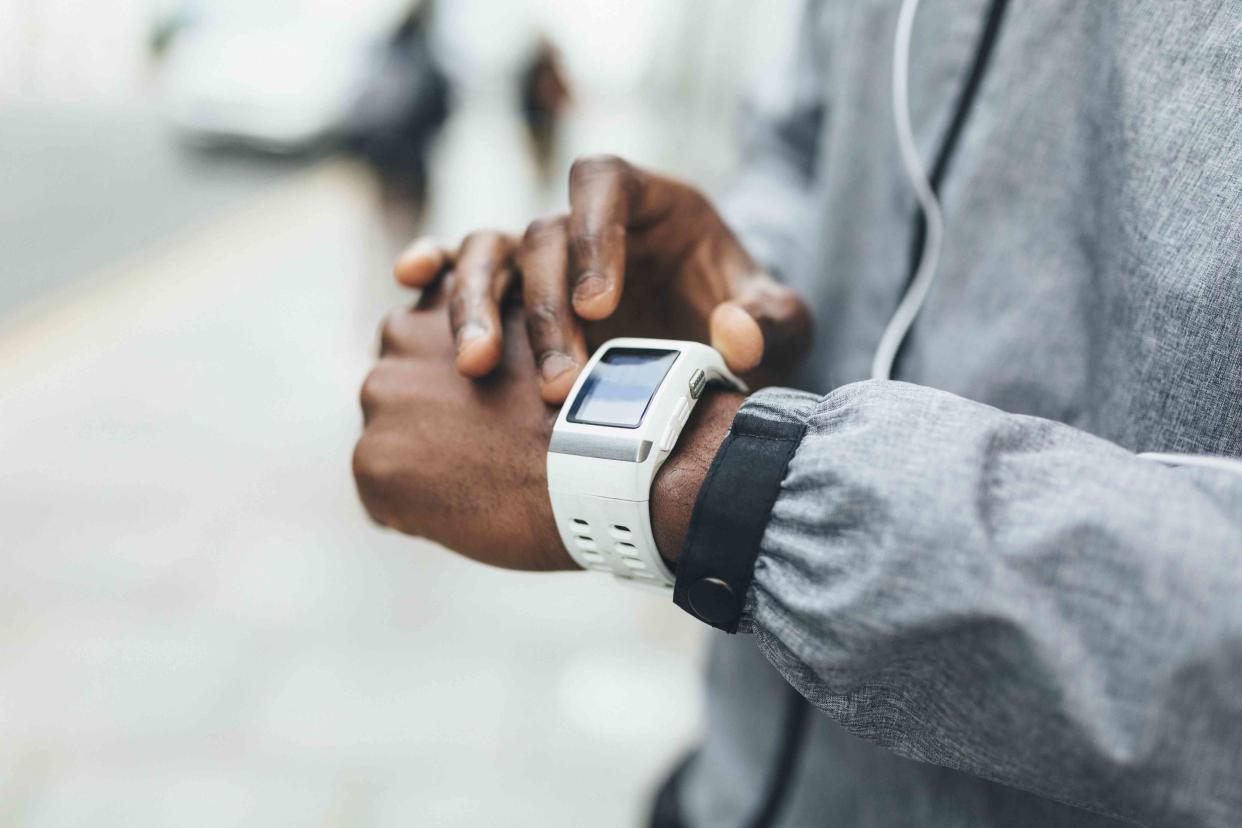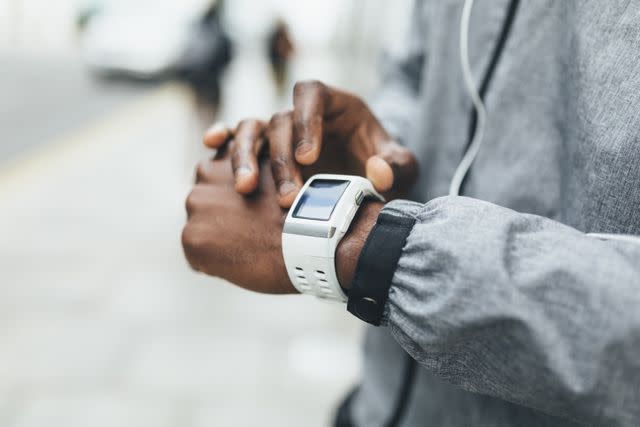Could Your Smartwatch Help Detect Parkinson's Disease Earlier?

Getty Images / Westend61
Fact checked by Nick Blackmer
A new study found that smartwatches could provide valuable insight into Parkinson’s disease symptoms.
This is because smartwatches can track how quickly an individual moves—slowed movements are often an early symptom of Parkinson’s.
Experts note that the earlier an individual is diagnosed with Parkinson’s, the more time there is to create treatment plans and prepare for the road ahead.
Your smartwatch could help identify Parkinson’s disease (PD) symptoms, according to a new study.
Parkinson’s disease is a brain disorder that results in uncontrollable, uncomfortable movements such as shaking or balance issues. Typically, symptoms worsen over time, but each case is very individual.
While nothing can replace traditional clinical appointments and screenings to diagnose the condition, it could be useful to have a tool to supplement understanding of a person’s shift in behaviors and movements that could hopefully lead to earlier diagnoses—and earlier interventions for improved quality of life.
The new research focused on using smartwatches as this supplemental tool.
Published in Nature Medicine, the study used artificial intelligence to analyze the data of 103,712 people who wore smartwatches, recording their speed of movement over single-week periods from the years 2013 to 2016.
Lead study author Cynthia Sandor, PhD, an emerging leader at the UK Dementia Research Institute at Cardiff University, told Health that while she and her team did expect to catch “subtle movement changes” in people prior to Parkinson’s diagnoses, they didn’t expect to see the reduction of people’s movement speeds that were similar to those with Parkinson’s.
Turns out, smartwatch data offered a bit of a bird’s eye view of how people’s movements were shifting over time and how that reflected larger changes in their overall health.
“We were further surprised by seeing how well the models trained on smartwatch data performed even in the general population including individuals diagnosed with other diseases,” Sandor said.

Getty Images / Westend61
Diagnosing Parkinson’s Disease
The prevalence of Parkinson’s disease has doubled over the past quarter century, with 2019 estimates showing about 8.5 million people live with the disease worldwide.
In the United States, the condition is second to Alzheimer’s disease as the most common neurodegenerative disorder.
Benjamin Walter, MD, a neurologist at the Center for Neuro-Restoration at Cleveland Clinic, told Health that Parkinson’s is typically diagnosed through a review of one’s clinical history and examinations from a specialist in neurological movement disorders. Walter, who is unaffiliated with the U.K. study, added that this condition isn’t typically one that relies on diagnosis from a blood or lab test.
In rare instances, an imaging scan known as the DaTscan may be used to examine the brain’s dopamine system, as a loss of dopamine can lead to Parkinson’s.
Walter explained that the traditional clinical exam administered by a skilled specialist in the field is the most tried and true method for diagnosis.
“Parkinson’s disease is diagnosed primarily based on characteristic clinical features of slowness, tremor rigidity, and gait and balance disorder,” Caroline M. Tanner, MD, PhD, professor and vice chair for clinical research at the Department of Neurology at Weill Institute for Neurosciences at the University of California, San Francisco (UCSF) told Health.
“Diagnosis can be inaccurate, more so in early disease,” she said. “Imaging studies including dopamine transporter imaging and MRI are often used as supportive information.”
Tanner, who is also unaffiliated with the new study echoed Walter that new advanced screening methods have emerged but are not the norm. She pointed to a biomarker test for a protein abnormality “that is the pathologic hallmark of PD” which was approved by the Food and Drug Administration in 2022.
She went on to explain that anytime a screening or test can help catch Parkinson’s disease at an earlier stage, it makes a huge difference in a patient’s life.
“Ideally, we would want to identify people with these very early changes even before the motor changes are detectable because we would hope to intervene to delay or prevent PD onset,” she said.
Related: Signs and Symptoms of Parkinson's Disease
How Movement Speed May Indicate Parkinson’s Disease
According to Sandor, previous research has shown that a clinical diagnosis of Parkinson’s “is preceded by a long prodromal phase.” Subtle motor shifts could appear with bradykinesia, or slowing of movement, being one of the first.
“Our study shows that smartwatches are capable of measuring this sub-threshold slowing of movement without the need for in-clinic visits or expensive equipment,” Sandor said.
Tanner noted that since this new research used machine learning algorithms to analyze the data, actual “clinical application would require more work.”
Walter said this kind of data is useful because the people wearing the smartwatches become their “own control group.” Essentially, you can compare how smartwatch data changed over time just based on how fast or slow someone’s movements were.
“You will see a lot of variability in how people move, noticing significant trends over time that are consistent in one particular individual that is going to be more striking and obvious to watch—you will be able to pick that out from the data, looking at [change in speed] for a longer period of time in the same individual,” he said.
How Smartwatch Technology Could Contribute to Parkinson’s Disease Patient Care
Sandor said that once her team’s findings are replicated and supported by further research, “screening for Parkinson’s in the general population could be facilitated through smartwatch data.”
She noted that while her team’s research is helpful, it’s currently a screening, not a diagnostic tool.
“Our tool would thus serve as a first identifier of people at risk who should be examined more thoroughly,” she said.
Sandor explained that by objectively quantifying motor symptoms, smartwatch data could be a simple, useful tool in diagnosing Parkinson's.
Tanner agreed that smartwatch data could certainly be helpful in screenings, suggesting that a person who is showing signs of changes in their movements might need additional assessment.
Walter added there are other changes in one’s behavior—beyond their movement—that could indicate the progression of Parkinson’s disease.
For instance, many people with the condition report loss of smell, constipation, and sleep behavior disorders.
Walter noted that wearable tech could also be applied to recording changes in sleep patterns, and this data could be coupled with smartwatch walking data to paint a fuller picture of what is shifting for an individual physically.
He echoed Tanner and Sandor that smartwatch technology is not a diagnostic tool—it simply provides data that supplements detailed screenings.
Catching Parkinson’s Disease Earlier
Supplemental data, like information from smartwatches, could be helpful in catching Parkinson’s disease earlier, and hopefully, providing interventions that could give people a better quality of life.
“An earlier diagnosis could allow early intervention,” Tanner said. “We do not have treatments right now to stop or slow progression—or cure disease—but this is an area of active research.”
Sandor added that an early diagnosis today could help the individual and their caretakers and family to better “make plans and prepare for the future.”
“We hope, that the early diagnosis can help to recruit the right individuals to clinical trials for neuroprotective treatments, that could benefit the most from drugs preserving the remaining neurons,” she explained.
Sandor said the next goal is to replicate the study results in an independent cohort of people and verify how applicable this kind of smartwatch data is in measuring potential movement changes.
“Obtaining a complete history of sensor data from individuals newly diagnosed with Parkinson’s disease could provide highly informative insights and greatly assist the Parkinson’s research community in studying the prodromal phase of the disease.”
Related: How To Prevent Parkinson’s Disease
For more Health news, make sure to sign up for our newsletter!
Read the original article on Health.

